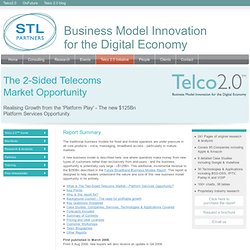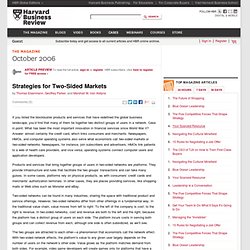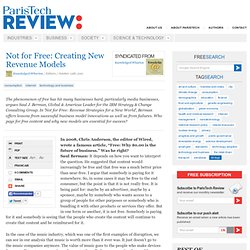

STL Partners : Business model innovation in the Telecoms-Media-Technology sector. 241 Pages of original research & analysis Covers 85 Companies including Apple & Amazon 9 detailed Case Studies including Google & Vodafone 30 Technologies & Applications including BSS-OSS, IPTV, Parlay-X and VOIP 100+ charts, 38 tables Proprietary industry research Click here to purchase the report Request a brochure Email us Report Summary The traditional business models for fixed and mobile operators are under pressure in all core products - voice, messaging, broadband access - particularly in mature markets.

A new business model is described here: one where operators make money from new types of customers rather than exclusively from end-users - and the business opportunity is potentially very large - c$125Bn. First published in March 2008. What is The Two-Sided Telecoms Market / Platform Services Opportunity? Key Points Market opportunity & market size. Who is this report for? Fixed & Mobile Broadband Operators - to set and drive strategy. Click here to purchase the report 1. 2. 3. 4. 5. PLATFORM COMPETITION IN TWO-SIDED MARKETS - Rochet - 2010 - Journal of the European Economic Association. Economics focus: Matchmakers and trustbusters. Economics focus: Two sides to every story. Strategies for Two-Sided Markets. The Idea in Brief If you listed the blockbuster offerings that have redefined the global business landscape, you’d find that many tie together two distinct groups of users.

HMOs, for instance, link patients to health-care providers. Search engines join Web surfers and advertisers. When successful, these platforms catalyze a virtuous cycle: More demand from one user group spurs more from the other. For example, the more video games developers (one user group) create for the Microsoft X-Box platform, the more players (the other user group) snap up the latest X-Box. But as Eisenmann, Parker, and Van Alstyne contend, managing platforms is tricky: Strategies that make traditional offerings successful won’t work in these two-sided markets.
The key challenge? If you seize a platform opportunity but don’t get it right the first time, someone else will. The Idea in Practice To ensure your platform’s success: Get Pricing Right Consider these pricing strategies: Cope with Winner-Take-All Competition. Business Model Innovation Hub - ... where visionaries, game changers, and challengers discuss business models.
Not for Free: Creating New Revenue Models. In 2008, Chris Anderson, the editor of Wired, wrote a famous article, “Free: Why $0.00 is the future of business.”

Was he right? Saul Berman: It depends on how you want to interpret the question. He suggested that content would increasingly be free and that free was a much better price than near-free. I argue that somebody is paying for it somewhere. So, in some cases it may be free to the end consumer, but the point is that it is not really free. In the case of the music industry, which was one of the first examples of disruption, we can see in our analysis that music is worth more than it ever was. Let’s take a company like Google that provides Gmail for free. So, again, back to my music company example. But in Google’s case, it is still Google that makes the money, just not on the email, but on the advertising.
Jerry Wind, you are a professor of marketing at Wharton School. Google is a great example. You focus a lot on workable business models in your book.